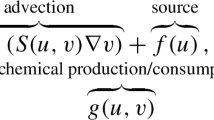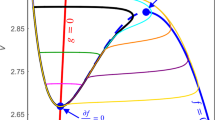Abstract
We have presented a new generation mechanism of slow spiking or repetitive discharges with extraordinarily long inter-spike intervals using the modified Hodgkin-Huxley equations (Doi and Kumagai, 2001). This generation process of slow firing is completely different from that of the well-known potassium A-current in that the steady-state current-voltage relation of the neuronal model is monotonic rather than the N-shaped one of the A-current. In this paper, we extend the previous results and show that the very slow spiking generically appears in both the three-dimensional Hodgkin-Huxley equations and the three dimensional Bonhoeffer-van der Pol (or FitzHugh-Nagumo) equations. The generation of repetitive discharges or the destabilization of the unique equilibrium point (resting potential) is a simple Hopf bifurcation. We also show that the generation of slow spiking does not depend on the stability of the Hopf bifurcation: supercritical or subcritical. The dynamics of slow spiking is investigated in detail and we demonstrate that the phenomenology of slow spiking can be categorized into two types according to the type of the corresponding bifurcation of a fast subsystem: Hopf or saddle-node bifurcation.
Similar content being viewed by others
References
Adams P (1982) Voltage-dependent conductances of vertebrate neurones. TINS-April, pp. 116–119.
Baer SM, Erneux T (1986) Singular Hopf bifurcation to relaxation oscillations. SIAM J. Appl. Math. 46: 721–739.
Baer SM, Erneux T, Rinzel J (1989) The slow passage through a Hopf bifurcation: Delay, memory effects, and resonance. SIAM J. Appl. Math. 49: 55–71.
Benoit E, Callot JL, Diener F, Diener M (1981) Chasse au canards. Collect. Math. 31: 37–119.
Bertram R, Butte MJ, Kiemel T, Sherman A (1995) Topological and phenomenological classification of bursting oscillations. Bull. Math. Biol. 57: 413–439.
Braaksma B (1998) Singular Hopf bifurcation in systems with fast and slow variables. J. Nonlinear Sci. 8: 457–490.
Canavier CC, Clark JW, Byrne JH (1991) Simulation of the bursting activity of neuron R15 in Aplisia: Role of ionic currents, calcium balance, and modulatory transmitters. J. Neurophysiol. 66: 2107–2124.
Carpenter GA (1977) A geometric approach to singular perturbation problems with applications to nerve impulse equations. J. Diff. Eqn. 23: 335–367.
Chay TR, Keizer J (1983) Minimal model for membrane oscillations in the pancreatic β-cell. Biophys. J. 42: 181–190.
Connor JA, Walter D and McKown R (1977) Neural repetitive firing: modifications of the Hodgkin-Huxley axon suggested by experimental results from crustacean axons. Biophys. J. 18: 81–102.
Crill WE, Schwindt PC (1983) Active currents in mammalian central neurons. TINS-June, pp. 236–240.
Cronin, J (1987) Mathematical Aspects of Hodgkin-Huxley neural theory. Cambridge Univ. Press.
Doedel E, Wang X, Fairgrieve T (1995) AUTO94–Software for continuation and bifurcation problems in ordinary differentialequations. CRPC-95-2, California Inst. of Tech.
Doi S, Inoue J, Sato S, Smith CE (1999) Bifurcation analysis of neuronal excitability and oscillations. In: Poznanski R, ed. Modeling in the Neurosciences: From Ionic Channels to Neural Networks, Chapter 16, Harwood Academic Publishers, pp. 443–473.
Doi S, Inoue J, Kumagai S (2004) Chaotic spiking in the Hodgkin-Huxley nerve model with slow inactivation of the sodium current. J. Integrative Neurosci. 3: 207–225.
Doi S, Kumagai S (2001) Nonlinear dynamics of small-scale biophysical neural networks. In: Poznanski R, ed. Biophysical Neural Networks: Foundations of Integrative Neuroscience, Chapter 10, Mary Ann Liebert, Inc., pp. 261–301.
Doi S, Nabetani S, Kumagai S (2001) Complex nonlinear dynamics of the Hodgkin-Huxley equations induced by time scale changes. Biol. Cybern. 85: 51–64.
Drover J, Rubin J, Su JH, Ermentrout B (2004) Analysis of a canard mechanism by which excitatory synaptic coupling can synchronize neurons at low firing frequencies. SIAM J. Appl. Math. 65: 69–92.
Ermentrout GB (1996) Type I membranes, phase resetting curves, and synchrony. Neural Comp. 8: 979–1001.
Fenichel N (1979) Geometric singular perturbation theory for ordinary differential equations. J. Diff. Eqn. 31: 53–98.
FitzHugh R (1959) Thresholds and plateaus in the Hodgkin-Huxley nerve equations. J. Gen. Physiol. 43: 867–896.
FitzHugh R (1961) Impulses and physiological states in theoretical models of nerve membrane. Biophy. J. 1: 445–466.
Fukai H, Doi S, Nomura T, Sato S (2000a) Hopf bifurcations in multiple parameter space of the Hodgkin-Huxley equations. I. Global Organization of bistable periodic solutions. Biol. Cybern. 82: 215–222.
Fukai H, Nomura T, Doi S, Sato S (2000b) Hopf bifurcations in multiple parameter space of the Hodgkin-Huxley equations. II. Singularity theoretic approach and highly degenerate bifurcations. Biol. Cybern. 82: 223–229.
Gerber B, Jakobsson E (1993) Functional significance of the A-current. Biol. Cybern. 70: 109–114.
Guckenheimer J (1996) Towards a global theory of singularly perturbed dynamical systems. Prog. Non. Diff. Eqn. Appl. 19: 213–225.
Guckenheimer J, Harris-Warrick R, Peck J, Willms A (1997) Bifurcation, bursting, and spike frequency adaptation. J. Comp. Neurosci. 4: 257–277.
Guckenheimer J, Hoffman K, Weckesser W (2000) Numerical computation of canards. Int. J. Bif. Chaos 10: 2669–2687.
Guckenheimer J, Holmes P (1983) Nonlinear Oscillations, Dynamical Systems, and Bifurcation of Vector Fields. Springer.
Guckenheimer J, Labouriau IS (1993) Bifurcation of the Hodgkin and Huxley equations: A new twist. Bull. Math. Biol. 55: 937–952.
Guckenheimer J, Oliva A (2002) Chaos in the Hodgkin-Huxley model. SIAM J. Appl. Dynam. Sys. 1:105–114.
Guckenheimer J, Willms AR (2000) Asymptotic analysis of subcritical Hopf-homoclinic bifurcation. Physica D 139: 195–216.
Gutkin BS, Ermentrout GB (1998) Dynamics of membrane excitability determine inter-spike interval variability: A link between spike generation mechanisms and cortical spike train statistics. Neural Comp. 10: 1047–1065.
Hassard B (1978) Bifurcation of periodic solutions of the Hodgkin-Huxley model for the squid giant axon. J. Theor. Biol. 71: 401–420.
Hayashi H, Ishizuka S (1992) Chaotic nature of bursting discharges in the Onchidium pacemaker neuron. J. Theor. Biol. 156: 269–291.
Hille B (1992) Ionic Channels of Excitable Membranes, 2nd ed. Sinauer Associates.
Hodgkin AL (1948) The local electric changes associated with repetitive action in a non-medullated axon. J. Physiol. 107: 165–181.
Hodgkin AL, Huxley AF (1952) A quantitative description of membrane current and its applications to conduction and excitation in nerve. J. Physiol. 117: 500–544.
Honerkamp J, Mutschler G Seitz R (1985) Coupling of a slow and a fast oscillator can generate bursting. Bull. Math. Biol. 47: 1–21.
Izhikevich EM (2000) Neural excitability, spiking, and bursting. Int. J. Bifn. Chaos 10: 1171–1266.
Jones C (1996) Geometric singular perturbation theory. In: Johnson R, ed. Dynamical Systems, Lecture Notes in Mathematics, Vol.1609, Springer.
Jones C, Kopell N (1994) Tracking invariant manifolds with differential forms. J. Diff. Eqn. 108: 64–88.
Keener J, Sneyd J (1998) Mathematical Physiology. Interdisciplinary Applied Mathematics, Vol. 8. Springer-Verlag, New York.
Llinas RR (1988) The intrinsic electrophysiological properties of mammalian neurons: Insights into central nervous system function. Science 242: 1654–1664.
Nagumo J, Arimoto S, Yoshizawa S (1962) An active pulse transmission line stimulating nerve axon. Proc. Inst. Radio Eng. 50: 2061–2070.
Neishtadt AI (1987) Persistence of stability loss for dynamical bifurcations I. Diff. Eqn. 23: 1385–1391.
Neishtadt AI (1988) Persistence of stability loss for dynamical bifurcations II. Diff. Eqn. 24: 171–176.
Noble D (1995) The development of mathematical models of the heart. Chaos. Sol. Frac. 5: 321–333.
Plant RE (1976) The geometry of the Hodgkin-Huxley model. Comp. Prog. Biomed. 6: 85–91.
Rinzel J (1978) On repetitive activity in nerve. Fed. Proc. 37: 2793–2802.
Rinzel J (1990) Discussion: Electrical excitability of cells, theory and experiment: Review of the Hodgkin-Huxley foundation and update. Bull. Math. Biol. 52: 5–23.
Rinzel J, Ermentrout GB (1989) Analysis of neuronal excitability and oscillations. In: Koch C, Segev I, eds. Methods in Neuronal Modeling: From Synapses to Networks, MIT Press, London.
Rinzel J, Lee YS (1986) On different mechanisms of membrane potential bursting. In: Othmer HG, ed. Nonlinear Oscillations in Biology and Chemistry, Springer, pp. 19–33.
Rinzel J, Miller RN (1980) Numerical calculation of stable and unstable periodic solutions to the Hodgkin-Huxley equations. Math. Biosci. 49: 27–59.
Rinzel J, Troy WC (1983) A one-variable map analysis of bursting in the Belousov-Zhabotinskii reaction. Contem. Math. 17: 411–427.
Rush ME, Rinzel J (1995) The potassium A-current, low firing rates and rebound excitation in Hodgkin-Huxley models. Bull. Math. Biol. 57: 899–929.
Szmolyan P, Wechselberger M (2001) Canards in R3. J. Diff. Eqs. 177: 419–453.
Traub RD, Wong RKS, Miles R, Michelson H (1991) A model of a CA3 hippocampal pyramidal neuron incorporating voltage-clamp data on intrinsic conductances. J. Neurophysiol. 66: 635–650.
Troy WC (1978) The bifurcation of periodic solutions in the Hodgkin-Huxley equations. Quart. Appl. Math. 36: 73–83.
Wang XJ, Rinzel J (1995) Oscillatory and bursting properties of neurons. In: Arbib MA, ed. The Handbook of Brain Theory and Neural Networks, MIT Press, pp. 686–691.
Wechselberger M (2005) Existence and bifurcation of canards in R3 in the case of a folded node. SIAM J. Appl. Dynam. Sys. 4: 101–139.
Author information
Authors and Affiliations
Corresponding author
Rights and permissions
About this article
Cite this article
Doi, S., Kumagai, S. Generation of Very Slow Neuronal Rhythms and Chaos Near the Hopf Bifurcation in Single Neuron Models. J Comput Neurosci 19, 325–356 (2005). https://doi.org/10.1007/s10827-005-2895-1
Received:
Revised:
Accepted:
Published:
Issue Date:
DOI: https://doi.org/10.1007/s10827-005-2895-1




